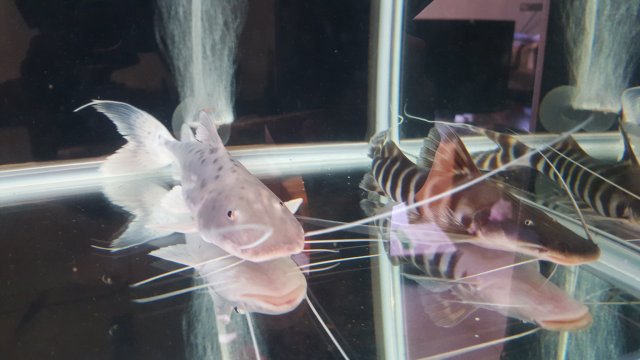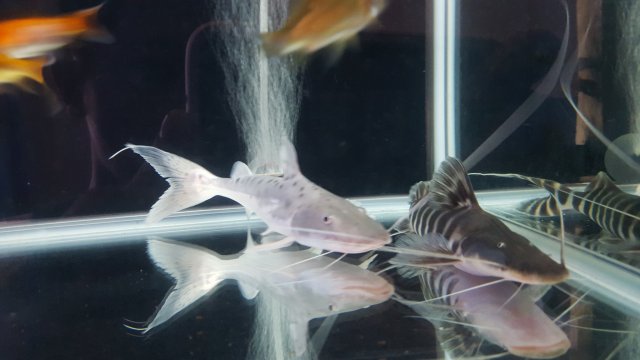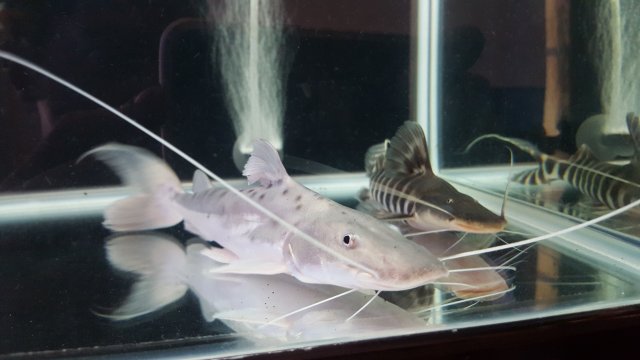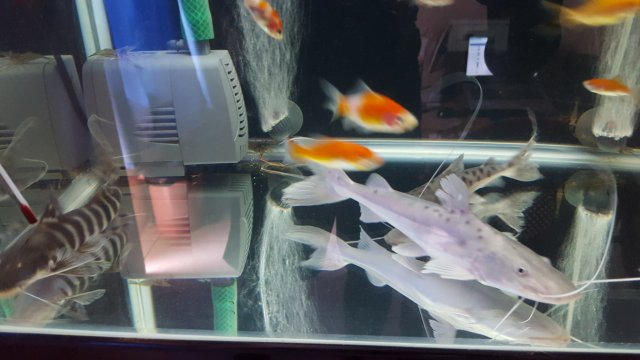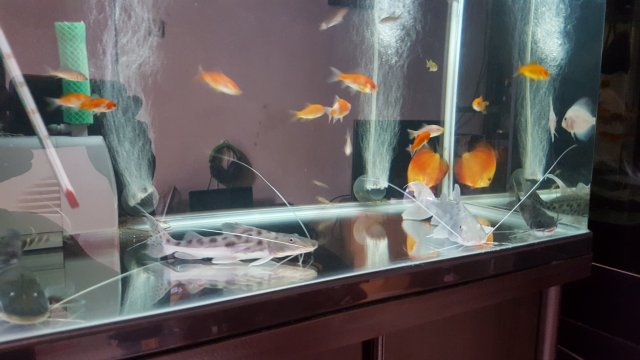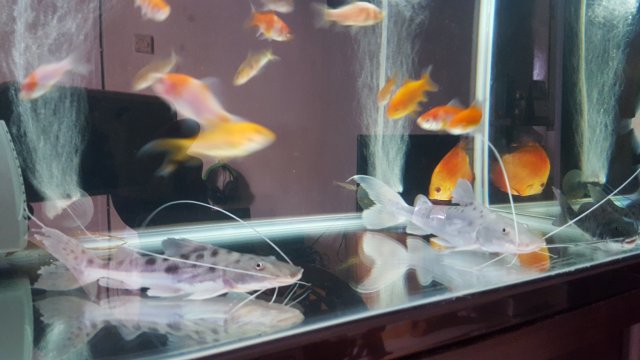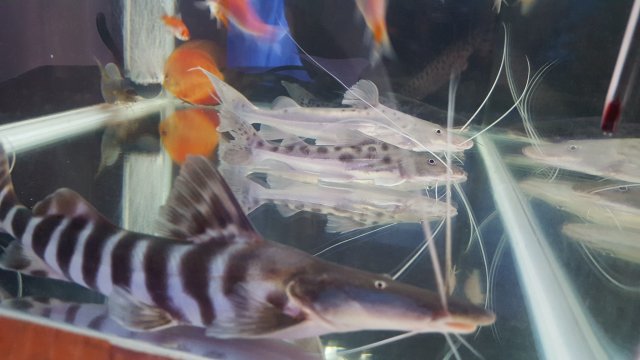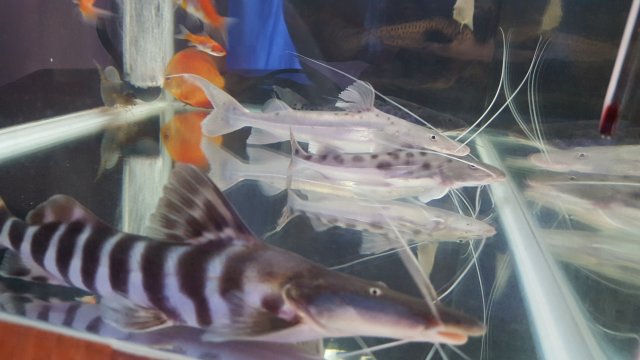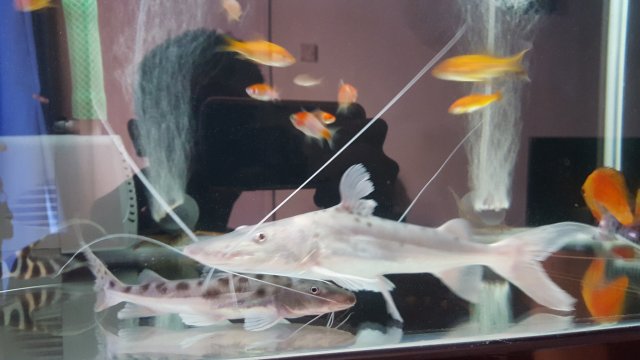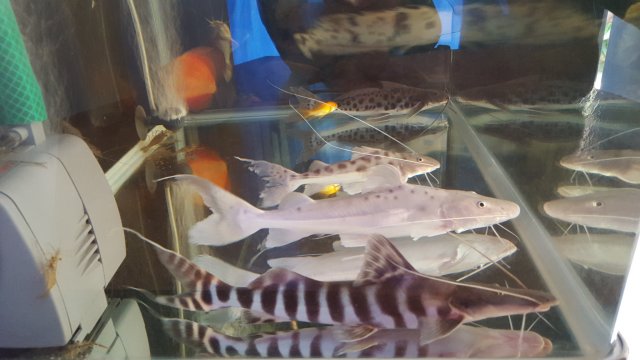Need ID for my catfish
- Thread starter horopgedrik
- Start date
You are using an out of date browser. It may not display this or other websites correctly.
You should upgrade or use an alternative browser.
You should upgrade or use an alternative browser.
In the 1st picture, left to right:
Brachyplatystoma capapretum
Calophysus macropterus
Brachyplatystoma filamentosum
Brachyplatystoma tigrinum
Capa vs fila is always tough (see this for more http://www.monsterfishkeepers.com/forums/threads/piraiba-pictures.520869/ ) ... but your case looks rather easy to my eye. Let's see what others say, esp. if Fugupuff (aka Wes Wong) sees this.
Brachyplatystoma capapretum
Calophysus macropterus
Brachyplatystoma filamentosum
Brachyplatystoma tigrinum
Capa vs fila is always tough (see this for more http://www.monsterfishkeepers.com/forums/threads/piraiba-pictures.520869/ ) ... but your case looks rather easy to my eye. Let's see what others say, esp. if Fugupuff (aka Wes Wong) sees this.
Thank you for
Thanks Viktor, but are you sure about it? Because some of my friends here tell that the 3rd fish can't be B. filamentosum because of its mouth shape and its eye position, they are convinced that it is also B. capapretum.
I wonder if out there, are there two types (subspecies or varieties maybe) of B. filamentosum? One is B. filamentosum with the vicious face, the darker grey body color, and more spots until 20'' size, and the other one is lighter grey body color, calm face, and less body spots just like mine?
In the 1st picture, left to right:
Brachyplatystoma capapretum
Calophysus macropterus
Brachyplatystoma filamentosum
Brachyplatystoma tigrinum
Capa vs fila is always tough (see this for more http://www.monsterfishkeepers.com/forums/threads/piraiba-pictures.520869/ ) ... but your case looks rather easy to my eye. Let's see what others say, esp. if Fugupuff (aka Wes Wong) sees this.
Thanks Viktor, but are you sure about it? Because some of my friends here tell that the 3rd fish can't be B. filamentosum because of its mouth shape and its eye position, they are convinced that it is also B. capapretum.
I wonder if out there, are there two types (subspecies or varieties maybe) of B. filamentosum? One is B. filamentosum with the vicious face, the darker grey body color, and more spots until 20'' size, and the other one is lighter grey body color, calm face, and less body spots just like mine?
What a great selection of catfish! Be great if it was a filamentosum where did you purchase it from?
What a great selection of catfish! Be great if it was a filamentosum where did you purchase it from?
Thanks mate, those tiny beasts was really spent all my savings. I bought them directly from importer here. Hope they are growing bigger and can join the others in the main tank. And I hope the 3rd species on first picture is truly piraiba, because a lot of doubt about it, even the price that I've paid for this tiny specimen, wasn't far from my "no-doubt-capa" price. So I need your help here guys.
Small dots : filamentosum
Big dots : capapretum
But some of my friends told me that 3rd specimen can't be fila because of its mouth shape and eye position, is that true?
I actually do not mind if it is indeed B. capapretum, because I got it at a reasonable price anyway, can be said to be cheap instead. I just curious because the importer stated with confidence that the fish is B. filamentosum at the first time, and many of my friends agreed with that after seeing this fish.
I've read many reviews about the difference between fila and capa, but I still can't get any idea with my own fish except the size of the body spot, body color, and behaviour. Thing that puzzles me is statement that piraiba may not have a W-shaped mouth, also it has smaller eye compared to the body proportion, and the famous "vicious" face. And the problem is my "not-sure-piraiba" fish are very opposite of that characteristics.
Apart from the spotting, the most important and obvious difference is that a fingerling / juvi fila will grow 3x-5x faster than a capa, ~6"+ a month. Or so they, who had filas, say.
So in 1 month there should be no mistake of telling true, healthy capa from true, healthy fila. As for not-yet-described species, that can easily be true. Capa was split from fila only recently by Dr. Lundberg and taxonomists guess that less than half of all Amazon fish species have been described to date!
IIRC, someone even spoke of hybrids between the brachies. Fugupuff had posted pics of some pretty amazing, different-looking juruense, for one. So that also throws a wrench in our wheels.
If you read the link I provided and see all the plentiful photos of capa vs fila juvies by Fugupuff and Co, then you'd know as much as I know on this issue. This thread is the only or rather the most helpful and reliable (as in people sharing the knowledge are trusted experts) source for the purpose, ime and imho.
I am not aware of authoritative claims that mouth shape, eye position or size, or the "viciousness" of "face" can be used as distinguishing traits. Fugupuff spoke only of smaller spots and the spots not occurring below lateral line, and longer (if intact) maxillary barbels as distinguishing traits.
Furthermore, when Necrocanis, who collaborates with Dr. Lundberg, reached out to him for ID advice, Dr. Lundberg got back with what he stated in his revision paper: only tooth patches can be used in reliable distinguishing of capa from fila. See the paper for that, please.
So in 1 month there should be no mistake of telling true, healthy capa from true, healthy fila. As for not-yet-described species, that can easily be true. Capa was split from fila only recently by Dr. Lundberg and taxonomists guess that less than half of all Amazon fish species have been described to date!
IIRC, someone even spoke of hybrids between the brachies. Fugupuff had posted pics of some pretty amazing, different-looking juruense, for one. So that also throws a wrench in our wheels.
If you read the link I provided and see all the plentiful photos of capa vs fila juvies by Fugupuff and Co, then you'd know as much as I know on this issue. This thread is the only or rather the most helpful and reliable (as in people sharing the knowledge are trusted experts) source for the purpose, ime and imho.
I am not aware of authoritative claims that mouth shape, eye position or size, or the "viciousness" of "face" can be used as distinguishing traits. Fugupuff spoke only of smaller spots and the spots not occurring below lateral line, and longer (if intact) maxillary barbels as distinguishing traits.
Furthermore, when Necrocanis, who collaborates with Dr. Lundberg, reached out to him for ID advice, Dr. Lundberg got back with what he stated in his revision paper: only tooth patches can be used in reliable distinguishing of capa from fila. See the paper for that, please.
Apart from the spotting, the most important and obvious difference is that a fingerling / juvi fila will grow 3x-5x faster than a capa, ~6"+ a month. Or so they, who had filas, say.
So in 1 month there should be no mistake of telling true, healthy capa from true, healthy fila. As for not-yet-described species, that can easily be true. Capa was split from fila only recently by Dr. Lundberg and taxonomists guess that less than half of all Amazon fish species have been described to date!
IIRC, someone even spoke of hybrids between the brachies. Fugupuff had posted pics of some pretty amazing, different-looking juruense, for one. So that also throws a wrench in our wheels.
If you read the link I provided and see all the plentiful photos of capa vs fila juvies by Fugupuff and Co, then you'd know as much as I know on this issue. This thread is the only or rather the most helpful and reliable (as in people sharing the knowledge are trusted experts) source for the purpose, ime and imho.
I am not aware of authoritative claims that mouth shape, eye position or size, or the "viciousness" of "face" can be used as distinguishing traits. Fugupuff spoke only of smaller spots and the spots not occurring below lateral line, and longer (if intact) maxillary barbels as distinguishing traits.
Furthermore, when Necrocanis, who collaborates with Dr. Lundberg, reached out to him for ID advice, Dr. Lundberg got back with what he stated in his revision paper: only tooth patches can be used in reliable distinguishing of capa from fila. See the paper for that, please.
Thank you for your explanation Viktor, very helpful. After following page per page, the link that you gave to me, now I am very confident that my specimen in fact isn't B. filamentosum, it is absolutely B. capapretum.
My specimen has very slowwwww growing rate to become 9' monster. Though leaving a little bit disappointed, still it was a lesson for me, and lesson don't come cheap LOL, so I have to save up again and trying to look again for the real B. filamentosum LOL.
Hmmm... then, that's an interesting case you got. Because the spotting is so obviously different on your two "now-supposed capapretum" specimen while they look to be close in size. Almost everyone is just like me and your vendor too - we see the spotting difference and assume the ID right away. Your info may show this is a wrong approach or at least that this approach should be taken with a grain of salt.
All the capas I've seen and the one I have recently purchased look like your "undisputed" capa, the first on the left in the first OP photograph.
It will be VERY informative for all of us, who are keeping track of the "capa vs fila vs unknown" ID evolution, if you update the thread with pics as fish grow, every now and then.
It'd also be great to get Input from experts. I'd send Fugupuff, Cgibby, and others, whose posts in the linked thread you liked, a PM bringing this thread to their attention.
As a side note, it appears true filas are very rare, to the point of perhaps only a handful currently owned in the US. It looks like several MFKers here are hunting for filas in Philippines, Indonesia, Malasia, etc. and found maybe only one. They fetch a high price of roughly $1000 per fingerling. IIRC, Fugupuff, a prominent importer of rare and rarest fishes himself, says this is because they are collected in very remote, difficult places in the Amazon.
All the capas I've seen and the one I have recently purchased look like your "undisputed" capa, the first on the left in the first OP photograph.
It will be VERY informative for all of us, who are keeping track of the "capa vs fila vs unknown" ID evolution, if you update the thread with pics as fish grow, every now and then.
It'd also be great to get Input from experts. I'd send Fugupuff, Cgibby, and others, whose posts in the linked thread you liked, a PM bringing this thread to their attention.
As a side note, it appears true filas are very rare, to the point of perhaps only a handful currently owned in the US. It looks like several MFKers here are hunting for filas in Philippines, Indonesia, Malasia, etc. and found maybe only one. They fetch a high price of roughly $1000 per fingerling. IIRC, Fugupuff, a prominent importer of rare and rarest fishes himself, says this is because they are collected in very remote, difficult places in the Amazon.



